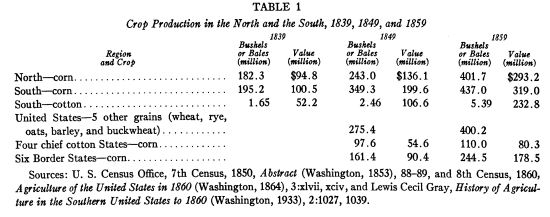As can be seen from Table 1 the South produced more corn than the North in all three of these census years. On a per capita basis Southern supremacy in corn production was even more marked, for the North was the more populous region. The North's population was double that of the South in 1859. Nor should the fact be overlooked that corn was the leading grain crop of the Nation, being twice as important as wheat, rye, oats, barley, and buckwheat combined. When analyzed, the corn production figures for 1839, 1849, and 1859 all tell about the same story.
For the purposes at hand, therefore, it will suffice to examine one set. The middle year, 1849, has been selected because the figures are more complete than for 1839, and the year is not at the very end of the period under investigation, as 1859 is. Table 2 reveals that in 1849 the 15 Southern States and the District of Columbia produced about 60 percent of the Nation's corn crop. Of the 16 leading corn-producing States in the Nation, North and South, 11 were in the South. True, the leading corn States were in the North but so were most of the States with little corn production. The upper South more than the western North deserved to be called the Corn Belt. In 1839 the three leading corn States were Tennessee, Kentucky, and Virginia, and as a region the upper South always led the Midwest in corn production.
Table 3 shows that corn excelled cotton in the South not only in weight, which was to be expected, but also in acreage cultivated and in value, neither of which is usually realized. Whether the modest figure of 200 pounds of cotton to the acre is taken- that was the average in North Carolina and Alabama about 1905-or the more generous estimate of 530 pounds to the acre for the South by J. D. B. DeBow in 1852, corn acreage was several times greater than cotton acreage. Even if the worst possible yield for cotton per acre is compared to the best possible yield for corn, corn acreage exceeded that of cotton. The truth must be that the great fields of cotton made more impression on everyone than the numerous fields and plots of corn. The situation resembled that prevailing in the cattle industry after the Civil War when the Great Plains States were famous for their vast herds but actually had fewer cattle in the aggregate than all the Eastern farms. The Great Plains States did a smaller business on a grand scale whereas the many farms of the East conducted a larger business on a small scale.

